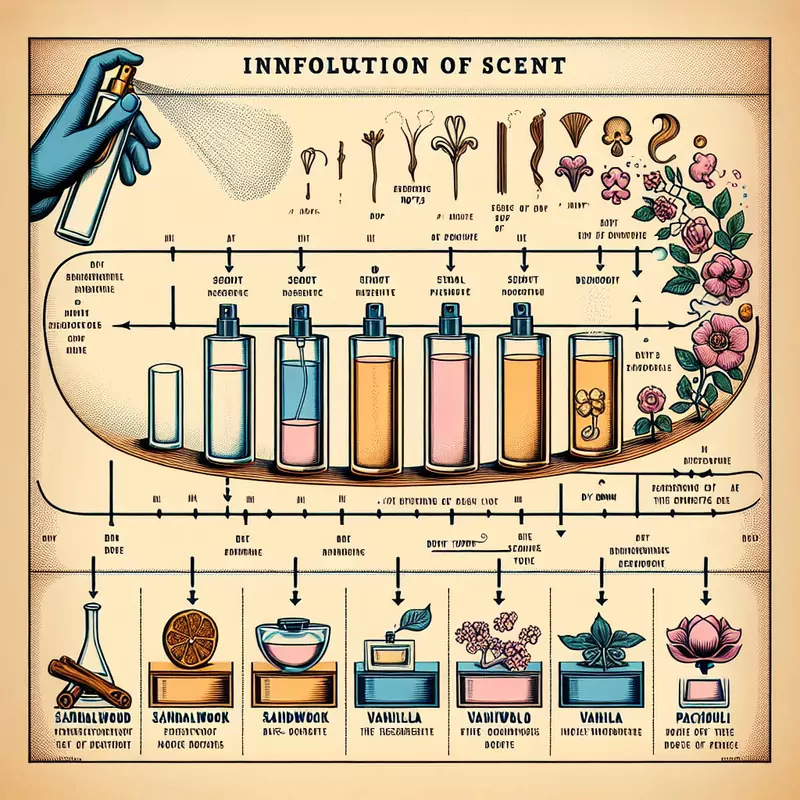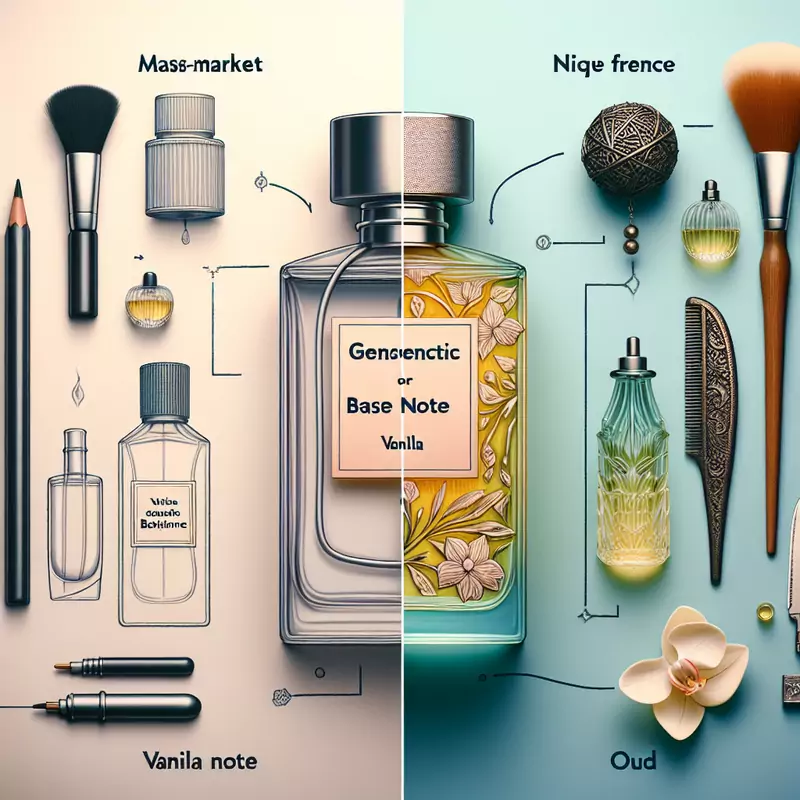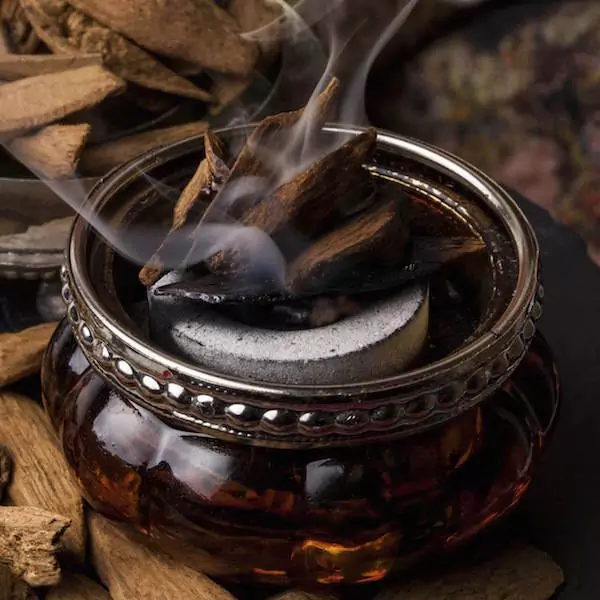Introduction to Perfumery and Base Notes
Perfume has always been more than just a way to smell pleasant; it’s a craft, an art form with a rich history that dates back to ancient times. Civilizations worldwide have used fragrances for ceremonies, personal adornment, and even as a status symbol. The perfume creation involves a symphony of notes, each crucial in forming a harmonious scent.

In perfumery, scents are categorized into three main types of notes: top, middle, and base notes. These notes are the building blocks of a fragrance, each with its unique role:
- Top Notes: Also known as head notes, they are the first impression of a perfume. They are usually light, volatile, and evaporate quickly.
- Middle Notes: Sometimes referred to as heart notes, they represent the main body of the perfume. They develop after the top notes and have a well-rounded character.
- Base Notes: These are the last to develop and the longest-lasting on the skin. They give depth and solidity to the fragrance.
Base notes are fundamental in fragrance creation. They act as the foundation for the rest of the perfume. These notes are typically rich and deep, such as musk, vanilla, or amber. They add depth and help fix the lighter top and middle notes, allowing the overall fragrance to linger longer on the skin.

The Chemistry of Base Notes: Natural vs Synthetic
The base notes of a perfume are made up of complex chemical compounds. These compounds can be sourced from natural ingredients like plants, resins, and animal products. For example, natural base notes can come from sandalwood, patchouli, or labdanum. Natural scents have been treasured throughout history for their depth and complexity.
However, synthetic base notes are also widely used in modern perfumery. These artificial compounds mimic natural scents and offer consistency and versatility. They can also create entirely new scents that don’t exist in the natural world. Synthetics have revolutionized the industry, allowing perfumers to expand their olfactory palette.

When comparing natural and synthetic base notes, each has its advantages and drawbacks:
| Natural Base Notes | Synthetic Base Notes |
|---|---|
| + Rich and complex | + Consistent quality |
| + Traditional appeal | + Greater variety |
| – Limited availability | + Often more affordable |
| – Can vary by harvest | – Can be less complex |
Choosing between natural and synthetic base notes depends on the desired scent profile, performance, and the ethical and sustainability considerations of the brand. At OEM Scent Lab, we understand the importance of these factors and work with our clients to select the best materials for their unique fragrance creations.
The Role of Base Notes in Scent Longevity and Evolution
Understanding the role of base notes is crucial for the longevity and evolution of a fragrance. Base notes are like the anchor of a perfume; they are composed of the largest and heaviest molecules, which evaporate slowly and remain on the skin long after the top and middle notes have dissipated. This enduring quality means that base notes are the final impression of the scent, the memory that lingers and continues to evolve.

As a wearer moves through their day, a perfume evolves, revealing its complexity in phases. This evolution is often referred to as the dry-down period, and it’s where the base notes shine. They blend with the wearer’s natural body chemistry, creating a unique and personal scent experience. Some classic perfumes are renowned for their distinctive base notes, which have become their signature and are recognizable many hours after application.
| Classic Perfume | Notable Base Note |
|---|---|
| Chanel No. 5 | Sandalwood |
| Shalimar by Guerlain | Vanilla |
| Acqua di Gio | Patchouli |
These perfumes offer a glimpse into how base notes contribute to the prestige and identity of a fragrance.
Innovations and Trends in Base Note Materials
As the perfume industry progresses, so do the innovations in base note materials. Perfumers constantly explore new substances that can provide novel scent experiences while being sustainable and ethically sourced. For instance, advances in green chemistry have led to the creation of base notes that are not only environmentally friendly but also add unique dimensions to a fragrance.
Trends in sustainability and ethical sourcing significantly impact the perfume industry. Consumers are increasingly aware of the provenance of the ingredients in their perfumes. As a result, there’s a growing demand for responsibly harvested and produced materials. This consumer consciousness is shaping how we at OEM Scent Lab and other perfume houses approach the creation of new fragrances.
Some trends we’re observing in the industry include:
- Sustainable Woods: Perfumers are turning to sustainably sourced wood materials, such as oud and cedarwood, for rich and warm base notes.
- Upcycled Ingredients: Ingredients that would otherwise be waste products are repurposed into valuable base notes, reducing environmental impact.
- Biomimicry: Mimicking natural processes to create base notes that are biodegradable and eco-friendly.

These trends influence the industry and align with consumer preferences for greener and more ethical products. As we continue to innovate, we remain committed to providing our clients with the latest base note materials that enchant the senses and respect the planet.
Designing Base Notes for Branding Perfume Identity: A Case Study
The base notes are pivotal when building a brand’s identity through scent. They are the lingering message of the fragrance, which stays with the consumer and creates a lasting impression. The choice of base notes can convey different emotions and values — from luxury and sophistication to naturalness and freshness.

Let’s consider a case study of a successful brand that has harnessed the power of base notes to enhance its identity. Take, for example, Jo Malone London, known for their simple yet elegant scents. Their fragrances often feature a distinctive base note, such as the velvety musk in ‘English Pear & Freesia,’ which provides a sophisticated and sensual trail that complements the brand’s image of refined simplicity.
In our approach at OEM Scent Lab, we collaborate closely with brands to understand their story and values. We then craft base notes that are tailor-made to resonate with their identity. Here’s how we do it:
1. Discovery: We hold in-depth discussions with the brand to understand its vision and target audience.
2. Selection: We select base notes that align with the brand’s messaging, whether a sense of luxury, adventure, or eco-consciousness.
3. Development: We develop custom scent formulations, balancing the base notes with the rest of the fragrance to create a cohesive and appealing scent profile.
This process ensures that the base notes embody the brand’s essence and leave a memorable impression on the consumer.
Fixatives and Their Importance in Base Note Stability
Fixatives are substances used in perfumery to stabilize the volatility of aromatic compounds and enhance the longevity of the fragrance. They play a critical role in ensuring that base notes and the perfume retain their character over time, especially when exposed to heat, light, and other environmental factors.

Selecting fixatives is a technical and creative decision that can significantly influence the final scent profile. They can be natural, like resins and balsams, or synthetic, like musk and ambergris-like compounds. The choice of fixative depends on the desired outcome regarding scent, strength, and longevity.
Here’s a glimpse into how fixatives interact with base notes:
- Enhancement: Fixatives can intensify certain facets of the base notes, making them more pronounced.
- Modulation: They can also modify the scent, adding new dimensions or smoothing out rough edges.
- Preservation: Fixatives help retain the integrity of the base notes over time, preventing them from fading away too quickly.
At OEM Scent Lab, we understand the science behind fixatives and how they interact with various base notes. We use this knowledge to create fragrances that smell wonderful at first spritz and maintain their allure throughout their wear.
How to Select and Blend Base Notes for DIY Creations
For those passionate about fragrances and enjoy the art of DIY perfume making, selecting and blending base notes is a crucial step in crafting a personal and unique scent. Here are some guiding principles to consider when choosing base notes for homemade perfumes:
1. Scent Profile: Identify the character you want your perfume to have—woody, musky, oriental, or floral, among others.
2. Intensity: Decide on the strength of the fragrance. Base notes can be potent, so consider how prominent you want these notes to be in your blend.
3. Compatibility: Ensure that your chosen base notes harmonize with your top and middle notes to create a balanced and cohesive scent.

When it comes to blending techniques, here’s a step-by-step approach to ensure success:
1. Gather Materials: Secure high-quality essential oils, absolutes, or aroma chemicals for your base notes, along with the necessary tools like droppers, glass vials, and alcohol or carrier oils.
2. Experiment: Start with small quantities and document your ratios. This allows you to adjust the blend without wasting materials.
3. Age Your Perfume: Allow your blend to age for several weeks. This maturation process lets the notes meld together, enhancing the overall fragrance.
Here are a few tips for achieving a harmonious scent:
- Layering: Apply the base notes first, then the middle notes, and finally the top notes. This allows you to build complexity in the scent.
- Balance: Aim for a balance between sweet, warm base notes and fresher, lighter ones to avoid an overpowering scent.
- Patience: Give your creation time. Some base notes may take a while to reveal their true character.
Base Notes in Market Segmentations: Mass vs Niche Perfumery
The selection and use of base notes can differ substantially between mass-market perfumes and niche creations. Mass-market perfumes often aim for broad appeal and may use base notes that are familiar and easily likable. On the other hand, niche perfumery might favor rare or unconventional base notes to create distinctive, avant-garde scents.
Here’s how market segmentation affects base note choices:
| Market Segment | Base Note Characteristics |
|---|---|
| Mass Market | Common, versatile, broadly appealing |
| Niche | Unique, exotic, potentially polarizing |
Consumer trends also influence base note selection. For instance, niche markets have a growing preference for natural and organic base notes, reflecting a desire for authenticity and sustainability.

Recent market research and expert analyses have highlighted a few key players in the base note arena. Patchouli, musk, amber, tonka bean, and vanilla are among the most popular choices for contemporary perfumes. These notes are favored for their rich, deep qualities that provide a grounding effect and a complex backdrop for the more volatile top and middle notes.
Let’s take a look at some visual data that encapsulates the most popular base notes of 2024:

Analyzing this data, we can observe that patchouli is a beloved choice for its earthy, sweet-herbaceous aroma, adding mystique to any fragrance. With its sensual and warm animalistic undertones, Musk remains a staple in the perfumer’s palette for its fixative properties. Amber provides a resinous, cozy warmth that comforts the senses, while tonka bean offers a slightly sweet, vanilla-esque aroma with hints of spice that can enhance the richness of a scent. Often considered a gourmand note, Vanilla itself has been reinvented unexpectedly, adding a modern twist to traditional perfumery.
The data and trends tell us what’s popular, but the art of perfumery is deeply personal. As a seasoned perfumer, I believe the true artistry lies in how these base notes are balanced with the rest of the scent profile. The perfect base is not just about the longevity of the fragrance; it’s about creating a harmonious blend that resonates with the wearer’s personal story and the emotions they wish to convey.
Crafting a Signature Scent: The Professional Process
The journey from concept to creation of a signature scent requires a blend of creativity, technical skill, and collaboration. As perfumers, we begin with a client’s vision, translating abstract ideas into a tangible fragrance that tells a story.

The perfumer’s toolkit includes various ingredients, from essential oils to synthetic molecules. Tools like scent strips, blending software, and olfactometers aid in the development process. Techniques such as layering notes and adjusting concentrations are employed to refine the scent.
Collaboration between perfumers and brands is essential to achieve a unique fragrance that speaks to the brand’s identity and resonates with its audience. This partnership ensures that the final product reflects the brand’s core values and leaves a lasting impression.
Conclusion: The Future of Base Notes in Perfumery
As we look to the future, base notes will continue to play an essential role in perfumery, with new trends and technologies shaping their use. Predictions include a rise in biotechnologically derived base notes, using artificial intelligence to predict scent preferences and innovative extraction methods that yield purer and more intense base notes.
The ongoing evolution of perfumery will likely see a fusion of tradition with cutting-edge science, resulting in familiar and groundbreaking fragrances. At OEM Scent Lab, we remain at the forefront of these developments, committed to crafting scents that captivate and inspire, today and into the future.




